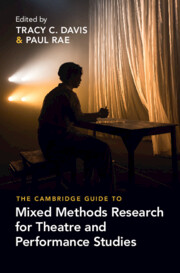50 results
Part I - Planning
-
- Book:
- The Cambridge Guide to Mixed Methods Research for Theatre and Performance Studies
- Published online:
- 01 February 2024
- Print publication:
- 08 February 2024, pp 37-122
-
- Chapter
- Export citation
Acknowledgements
-
- Book:
- The Cambridge Guide to Mixed Methods Research for Theatre and Performance Studies
- Published online:
- 01 February 2024
- Print publication:
- 08 February 2024, pp xvii-xviii
-
- Chapter
- Export citation
Copyright page
-
- Book:
- The Cambridge Guide to Mixed Methods Research for Theatre and Performance Studies
- Published online:
- 01 February 2024
- Print publication:
- 08 February 2024, pp iv-iv
-
- Chapter
- Export citation
Contents
-
- Book:
- The Cambridge Guide to Mixed Methods Research for Theatre and Performance Studies
- Published online:
- 01 February 2024
- Print publication:
- 08 February 2024, pp v-vi
-
- Chapter
- Export citation
Contributors
-
- Book:
- The Cambridge Guide to Mixed Methods Research for Theatre and Performance Studies
- Published online:
- 01 February 2024
- Print publication:
- 08 February 2024, pp ix-xvi
-
- Chapter
- Export citation
Index
-
- Book:
- The Cambridge Guide to Mixed Methods Research for Theatre and Performance Studies
- Published online:
- 01 February 2024
- Print publication:
- 08 February 2024, pp 321-328
-
- Chapter
- Export citation
Tables
-
- Book:
- The Cambridge Guide to Mixed Methods Research for Theatre and Performance Studies
- Published online:
- 01 February 2024
- Print publication:
- 08 February 2024, pp viii-viii
-
- Chapter
- Export citation
Reviews
-
- Book:
- The Cambridge Guide to Mixed Methods Research for Theatre and Performance Studies
- Published online:
- 01 February 2024
- Print publication:
- 08 February 2024, pp ii-ii
-
- Chapter
- Export citation
Conclusion:
- from Part III - Interpreting
-
-
- Book:
- The Cambridge Guide to Mixed Methods Research for Theatre and Performance Studies
- Published online:
- 01 February 2024
- Print publication:
- 08 February 2024, pp 300-320
-
- Chapter
- Export citation
Part III - Interpreting
-
- Book:
- The Cambridge Guide to Mixed Methods Research for Theatre and Performance Studies
- Published online:
- 01 February 2024
- Print publication:
- 08 February 2024, pp 213-320
-
- Chapter
- Export citation
Part II - Doing
-
- Book:
- The Cambridge Guide to Mixed Methods Research for Theatre and Performance Studies
- Published online:
- 01 February 2024
- Print publication:
- 08 February 2024, pp 123-212
-
- Chapter
- Export citation
Figures
-
- Book:
- The Cambridge Guide to Mixed Methods Research for Theatre and Performance Studies
- Published online:
- 01 February 2024
- Print publication:
- 08 February 2024, pp vii-vii
-
- Chapter
- Export citation

The Cambridge Guide to Mixed Methods Research for Theatre and Performance Studies
-
- Published online:
- 01 February 2024
- Print publication:
- 08 February 2024
Quantifying the psychological and behavioural consequences of a diagnostic label for non-cancer conditions: systematic review
-
- Journal:
- BJPsych Open / Volume 9 / Issue 3 / May 2023
- Published online by Cambridge University Press:
- 19 April 2023, e73
-
- Article
-
- You have access
- Open access
- HTML
- Export citation
Illustrations
-
- Book:
- Real Theatre
- Published online:
- 27 December 2018
- Print publication:
- 27 December 2018, pp x-xii
-
- Chapter
- Export citation
Dedication
-
- Book:
- Real Theatre
- Published online:
- 27 December 2018
- Print publication:
- 27 December 2018, pp v-vi
-
- Chapter
- Export citation
Chapter 5 - The Theatre Assembled
- from Part II
-
- Book:
- Real Theatre
- Published online:
- 27 December 2018
- Print publication:
- 27 December 2018, pp 122-157
-
- Chapter
- Export citation
Conclusion
-
- Book:
- Real Theatre
- Published online:
- 27 December 2018
- Print publication:
- 27 December 2018, pp 207-216
-
- Chapter
- Export citation
Contents
-
- Book:
- Real Theatre
- Published online:
- 27 December 2018
- Print publication:
- 27 December 2018, pp ix-ix
-
- Chapter
- Export citation
Part I
-
- Book:
- Real Theatre
- Published online:
- 27 December 2018
- Print publication:
- 27 December 2018, pp 27-80
-
- Chapter
- Export citation



